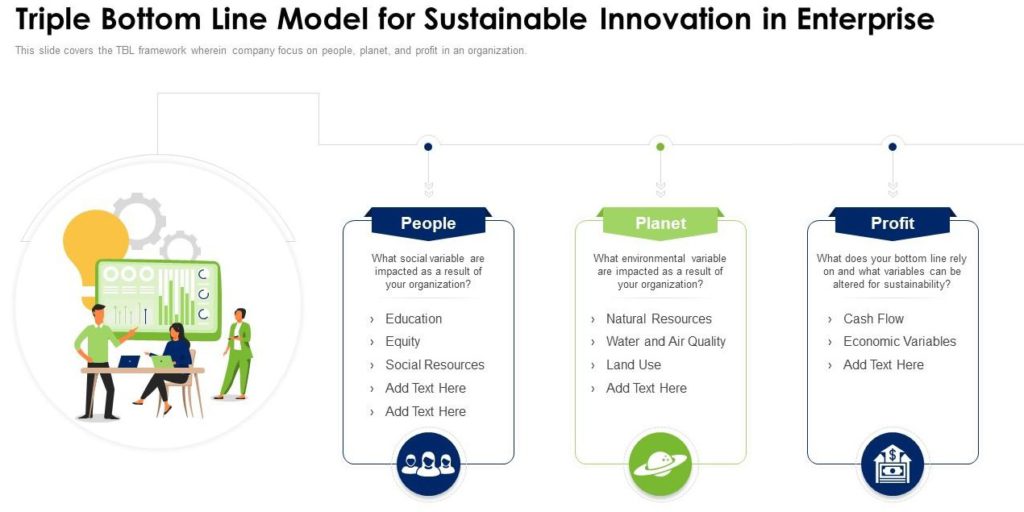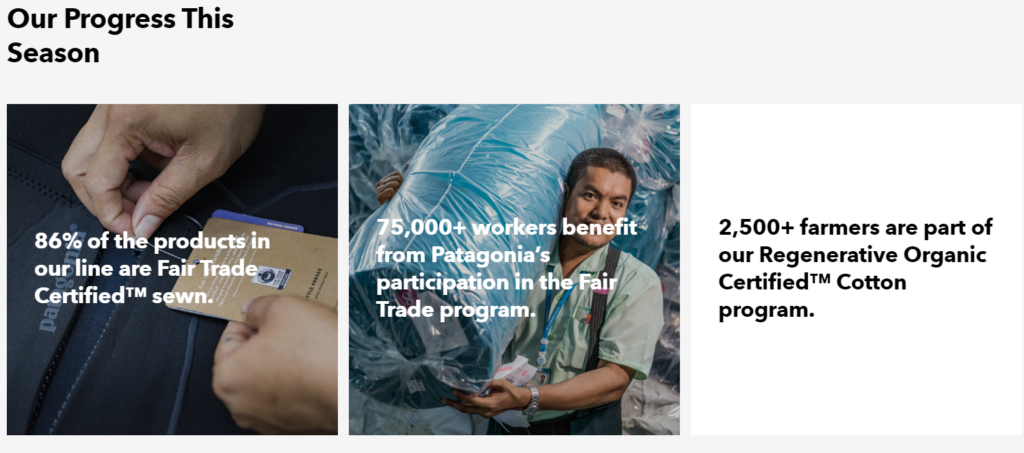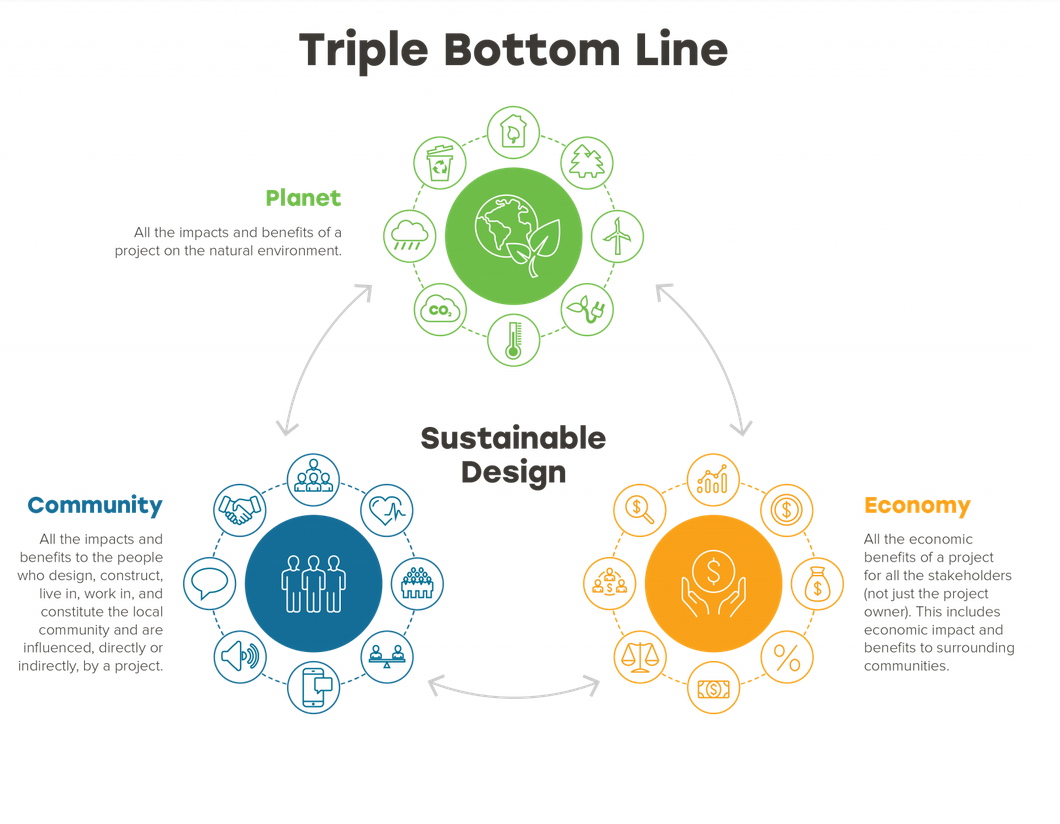|
|
In today’s world, businesses cannot afford to focus solely on profits. Customers, investors, and employees are increasingly concerned about the impact of businesses on the environment and society.
Enter the Triple Bottom Line (TBL), a framework that considers not only economic outcomes but also social and environmental impacts.
TBL recognizes that a business’s success should not only be measured by its financial performance but also by its contributions to the well-being of people and the planet.
This article delves into the concept of the Triple Bottom Line and how it has become a crucial consideration for businesses in the 21st century. We will explore the three pillars of TBL – people, planet, and profits – and how they interconnect with each other.
With the world facing significant challenges such as climate change and social inequality, understanding and implementing TBL can make all the difference in building a sustainable and prosperous future for businesses and society at large.
What Is Triple Bottom Line?

source: https://www.slideteam.net/business-strategy-best-practice-tools-triple-bottom-line-model-for-sustainable-innovation.html
Triple Bottom Line (TBL) is a concept that goes beyond the traditional approach of measuring a business’s success solely by its financial performance.
It is a framework that considers the impact of a business on society and the environment, in addition to its financial bottom line.
In other words, TBL recognizes that a business’s success should be measured by its contributions to the well-being of people and the planet, as well as its profitability.
The origins of the term go back to the 1980s and 1990s, first with Freer Spreckley and “Social Audit – A Management Tool for Co-operative Working,” then John Elkington and “Cannibals with Forks: the Triple Bottom Line of 21st Century Business.”
The concept gained traction over time and is now widely used by businesses and organizations globally to measure their sustainability performance.
TBL consists of three pillars, commonly referred to as the “3 Ps”: people, planet, and profits. These pillars are interconnected, and a business’s success depends on its ability to balance and optimize all three. Let’s take a closer look at each pillar.
People
The “people” pillar of TBL focuses on the impact of a business on its employees, customers, and the communities it operates in. It includes factors such as workplace diversity and inclusion, employee welfare, and community development.
A business that prioritizes the “people” pillar invests in the well-being of its employees, providing fair compensation, benefits, and opportunities for growth and development.
It also considers the impact of its operations on the community, striving to create a positive social effect through philanthropic initiatives and responsible business practices.
For example, Patagonia, an outdoor clothing and gear company, is known for its commitment to social and environmental responsibility.

source: https://www.patagonia.com/social-responsibility/
The company provides fair wages, comprehensive benefits, and a supportive work environment for its employees and has a robust social and environmental responsibility program that includes environmental activism, fair trade practices, and community engagement initiatives.
Planet
The “planet” pillar of TBL focuses on the environmental impact of a business’s operations. It includes factors such as carbon emissions, waste management, and resource conservation.
A business that prioritizes the “planet” pillar takes steps to minimize its environmental footprint, adopting sustainable practices that reduce waste, conserve resources, and mitigate environmental risks.
It also considers the impact of its products and services on the environment, striving to develop eco-friendly and sustainable solutions that benefit both the business and the planet.
For example, Tesla, an electric vehicle and clean energy company, is known for its commitment to environmental sustainability.

The company’s products and services are designed to reduce carbon emissions and promote clean energy, and it has implemented sustainable practices throughout its operations, such as using renewable energy sources and recycling waste materials.
Profits
The “profits” pillar of TBL focuses on the financial performance of a business. It includes factors such as revenue growth, profitability, and return on investment.
A business that prioritizes the “profits” pillar aims to generate sustainable financial returns, balancing profitability with social and environmental responsibility. It takes a long-term view, recognizing that sustainable business practices contribute to long-term financial success.
For example, Unilever, a multinational consumer goods company, has adopted a sustainable business model that integrates TBL principles into its operations.
The company’s Sustainable Living Plan aims to improve its environmental and social impact while growing its business sustainably, with a goal to double its size while halving its environmental footprint.
Benefits of Adopting TBL
Adopting TBL can provide a range of benefits for businesses, including:

source: https://designwithma.com/insights/making-the-business-case-for-triple-bottom-line-and-esg/
Improved Brand Image
By prioritizing the “people” and “planet” pillars of TBL, businesses can build a positive brand image and reputation, which can lead to increased trust and loyalty from customers, investors, and other stakeholders.
A positive brand image can differentiate a business from its competitors and attract socially and environmentally conscious consumers, who are increasingly seeking out businesses that prioritize sustainability and social responsibility.
Increased Customer Loyalty
Adopting TBL can also lead to increased customer loyalty, as consumers are increasingly looking for businesses that align with their priorities. In fact, seven in ten customers say they choose to buy from companies that reflect their personal values.
Businesses that prioritize social and environmental responsibility can build strong connections with customers who share these values, leading to increased customer loyalty and repeat business.
Reduced Risks
Adopting TBL can also help businesses reduce risks related to social and environmental issues, such as reputational damage, regulatory compliance, and supply chain disruptions.
By proactively addressing social and environmental risks, businesses can mitigate potential negative impacts and build resilience against unexpected events.
Improved Innovation
Adopting TBL can drive innovation by encouraging businesses to think creatively about how they can address social and environmental challenges while also achieving sustainable financial outcomes.
Considering social and environmental impact as a core aspect of business strategy can help identify new opportunities for innovation and growth.
Attracting Top Talent
Adopting TBL can also help businesses attract top talent by demonstrating a commitment to social and environmental responsibility. In today’s job market, employees are increasingly looking for employers that share their beliefs and convictions.
By prioritizing TBL, businesses can attract and retain employees who are passionate about making a positive impact in the world. Actually, most workers want to work in companies that share their values, and 40% of employees claim they would quit their job if their employer expressed an opinion on a political issue they don’t agree with.
Access to Capital
Adopting TBL can also provide businesses with access to capital from socially responsible investors.

Socially responsible investors are increasingly looking for businesses that prioritize sustainability and social responsibility and are willing to invest in companies that demonstrate a commitment to TBL.
According to Harvard Business Review, environmental, social, and governance (ESG) issues are quite universally important for senior executives, shareholders, and investors.
Challenges of Adopting TBL
While adopting TBL can provide numerous benefits for businesses, it can also present challenges and require significant changes in business practices and culture.
Integration Across the Business
One of the key challenges businesses face when adopting TBL is integrating social and environmental considerations into all aspects of their operations.
This requires a shift in mindset from viewing sustainability as an add-on to seeing it as an integral part of business strategy and culture.
It also demands developing systems and processes for measuring, monitoring, and reporting on social and environmental performance across the organization.
It should include everything from supply chain management to employee engagement and customer experience.
Measuring Impact
Another challenge of adopting TBL is measuring the impact of social and environmental initiatives.
While financial metrics such as revenue and profitability are easily quantifiable, social and environmental effects can be more difficult to measure and track.
Businesses need to develop robust metrics and reporting systems to accurately measure and inform on their influence. It also requires collecting, analyzing, and reporting data in a timely manner to ensure that social and environmental performance is being effectively monitored.
Balancing Priorities
Finally, balancing the three pillars of TBL can be challenging. It requires businesses to strike a balance between economic performance and social and environmental responsibility to ensure that all priorities are being addressed.
This is particularly difficult in situations where there is tension between short-term profits and long-term sustainability, such as when deciding whether or not to invest in energy-efficient equipment or future-proof technologies.
Conclusion
In today’s world, businesses need to recognize that their success is not solely defined by profits. Adopting a Triple Bottom Line approach – considering people, the planet, and profits as interdependent pillars of success – can help businesses create long-term value for both themselves and society at large.
It requires integrating sustainability into all aspects of the business while balancing short-term profitability with long-term social and environmental responsibility. While this may present challenges such as measuring impact or balancing priorities, it can ultimately lead to increased customer loyalty, improved innovation opportunities, access to capital from socially responsible investors, and more.













No Comments